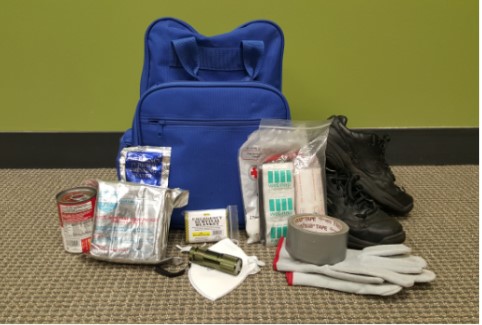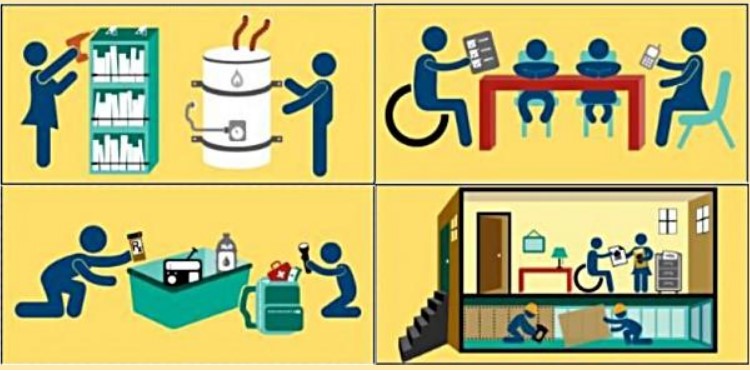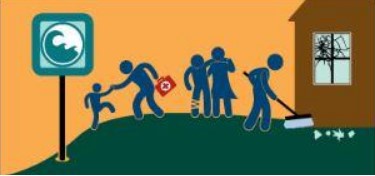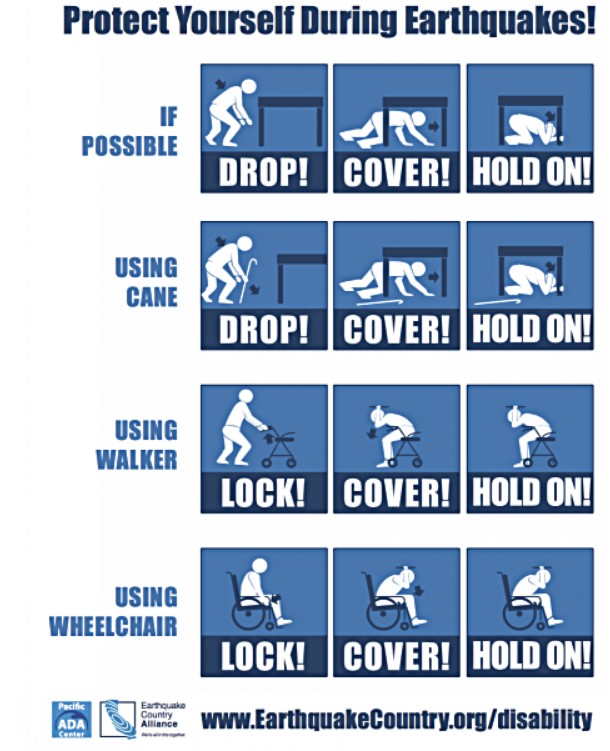Earthquake Preparedness
Learn what to do before, during, and after an earthquake.
With the Hayward fault cutting through the City, Berkeley faces a significant earthquake risk. Earthquakes can't be predicted--that is why it is important to know how to be ready for an earthquake, the actions to take during shaking, and what to do after the shaking stops.
You can also read about natural disasters in Berkeley and how we're getting ready for them.
What to do before an earthquake
Most injuries from earthquakes are from falling objects. Prevent dangerous situations by taking a few steps now to prepare.
- Make a disaster plan with your household, including a meeting spot and emergency contact numbers.
- Download the MyShake app (available in the Apple App and Google Play stores) and learn about the State of California's Earthquake Early Warning System.
- Prepare an emergency plan for pets.
- Make a disaster kit with enough food and water for at least 7 days, and store it in your home.

- Learn how to turn off gas valves and other utilities.
- Secure items that could fall and cause injuries (e.g., bookshelves, mirrors, light fixtures, water heater). Prepare your home.
- Store important documents electronically and in your kit (birth certificates, insurance forms, and house documents).
- Teach everyone in your household "Drop, Cover, and Hold On!" and practice together.
- Consider purchasing earthquake insurance coverage.
- Learn more about options for retrofitting your home.

What to do during an earthquake
- DROP - Get to the floor so that you don't fall down. Shaking may be so powerful that you are knocked over if you try to move.
- COVER - The best way to protect yourself from falling objects is to get under a solid table or other furniture that can shield you. If you can't get under furniture, protect your head with a pillow, a book, or your hands.
- HOLD ON - If you are under a table or sitting on a chair or couch, hold on to the furniture so that you move with it and stay protected.
If you are using a wheelchair or a walker, you should LOCK, COVER AND HOLD ON: Lock the brakes of your wheelchair or walker, cover your head and neck, and hold on during shaking.
Additionally, observe and act accordingly in the following situations:
- Outdoors: stay away from buildings, trees, and power lines.
- Driving: move away from overpasses, come slowly to a stop in a safe area, and stay in your vehicle. Stay off bridges. Listen to the radio for emergency information.
- In bed: stay in bed and cover your head with a pillow.
- In a high-rise building: stay inside, on the same floor. Get under a desk and stay away from outside walls and windows. Do not use the elevator.
- Near the shore: Follow steps as indicated above. If severe shaking lasts 20 seconds or more, immediately move to higher ground – the earthquake may have generated a tsunami.
What to do after an earthquake
- Put on shoes with thick soles to protect your feet from broken glass and debris.
- Check yourself and others around you for injuries. If anyone needs help, do basic first aid.
- For life-threatening emergencies, call 911 to contact emergency services. Otherwise, stay off the phone to leave lines clear for emergency responders.
- Check gas, water, electrical lines, and appliances for damage. Only turn off the gas if you smell gas or smoke, see a fire, or otherwise suspect a broken gas main.
- Check for building damage and potential safety hazards, like cracks around chimneys or foundations.
- Once safe, monitor local news reports via battery-operated radio, TV, social media, and cell phone text alerts for emergency information and instructions. See the emergency alerting page for more details.
- Check in with your household’s out-of-state contact: send a text message or send/post a message on social media to let your loved ones know where you are and that you are safe.
- Expect aftershocks.

More resources for people with disabilities or access and functional needs
Visit the Earthquake Country Alliance’s Accessibility Resources.
Download the Earthquake Preparedness Guide for Seniors, People with Disabilities, and Others with Access and Functional Needs (AFN).

Where to get information before, during, and after an earthquake or other emergencies
Sign up for or monitor multiple emergency alerting systems. Additionally, check these resources: